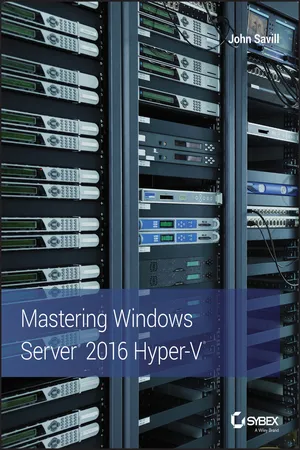
- English
- ePUB (mobile friendly)
- Available on iOS & Android
Mastering Windows Server 2016 Hyper-V
About this book
Build a seamless, flexible, full-service datacenter solution
Microsoft Windows Server 2016 Hyper-V is the IT administrator's guide to this rising datacenter solution. Hyper-V has already surpassed VMWare in datacenter management, identity service for multiple devices, and more; this book shows you how to harness the power of this hypervisor to simplify the infrastructure, reduce costs, improve productivity, and better manage system resources. From a tour of the technology through architecture, deployment, and integration of System Center, Microsoft Azure, and Microsoft Azure Stack, the discussion illustrates the skills you need to create a complete solution for optimum enterprise management. Coverage includes Windows Azure capabilities for virtual machines, managing a hybrid cloud, IaaS, storage capabilities, PowerShell, and more, with practical real-world guidance from a leading authority in the field.
Hyper-V has recently undergone improvements in scalability and features that have positioned it as an ideal solution in the Small/Medium Business and Enterprise markets. This book shows you how to exploit these new capabilities to build a robust data solution for your organization.
- Discover the capabilities of Microsoft Hyper-V
- Architect a Hyper-V datacenter solution
- Plan and manage a deployment or migration
- Integrate complementary technologies for full scalability
Data is everywhere—on desktops, laptops, phones, and multiple operating systems, accessed through email, text messages, web searches, online services, and more. All of this data must be stored, accessible, updated, backed up, secured, managed, sorted, and analyzed—sometimes instantly. Hyper-V is the rising star in the virtualization space, and Microsoft Windows Server 2016 Hyper-V shows you how to turn greater capabilities into better datacenter solutions.
Frequently asked questions
- Essential is ideal for learners and professionals who enjoy exploring a wide range of subjects. Access the Essential Library with 800,000+ trusted titles and best-sellers across business, personal growth, and the humanities. Includes unlimited reading time and Standard Read Aloud voice.
- Complete: Perfect for advanced learners and researchers needing full, unrestricted access. Unlock 1.4M+ books across hundreds of subjects, including academic and specialized titles. The Complete Plan also includes advanced features like Premium Read Aloud and Research Assistant.
Please note we cannot support devices running on iOS 13 and Android 7 or earlier. Learn more about using the app.
Information
Chapter 1
Introduction to Virtualization and Microsoft Solutions
- Articulate the key value propositions of virtualization.
- Understand the differences in functionality between the various versions of Hyper-V.
- Differentiate between the types of cloud services and when each type is best utilized.
The Evolution of the Datacenter
One Box, One Operating System
UNDERSTANDING X86
PROCESSOR
IS THERE A BIG AND A LITTLE THREAD WITH HYPERTHREADING?
MEMORY
Table of contents
- Cover
- Title page
- Copyright
- Dedication
- Acknowledgments
- About the Author
- Introduction
- Chapter 1 Introduction to Virtualization and Microsoft Solutions
- Chapter 2 Virtual Machine Resource Fundamentals
- Chapter 3 Virtual Networking
- Chapter 4 Storage Configurations
- Chapter 5 Managing Hyper-V
- Chapter 6 Maintaining a Hyper-V Environment
- Chapter 7 Failover Clustering and Migration Technologies
- Chapter 8 Hyper-V Replica and Cloud Orchestration
- Chapter 9 Implementing the Private Cloud, SCVMM, and Microsoft Azure Stack
- Chapter 10 Containers and Docker
- Chapter 11 Remote Desktop Services
- Chapter 12 Microsoft Azure IaaS, Storage, and Networking
- Chapter 13 Bringing It All Together with a Best-of-Breed Cloud Solution
- Appendix The Bottom Line
- EULA